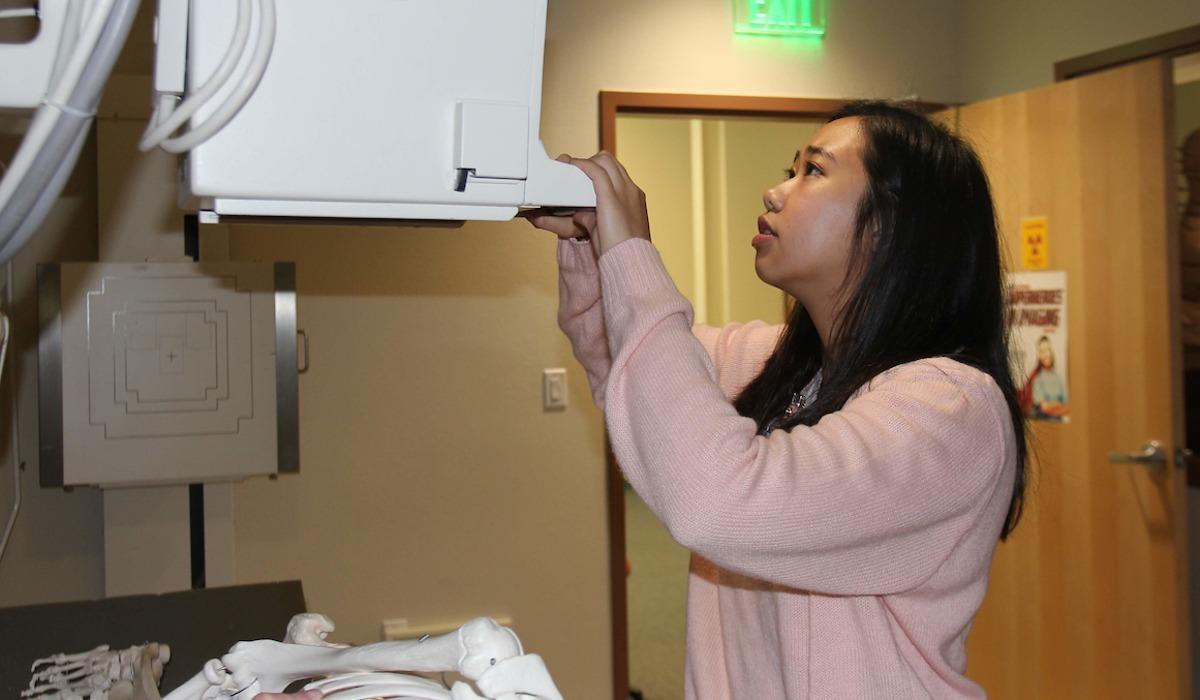
X-ray vision may be a superpower of your favorite comic book heroes, but Radiologic Technologists wield their skills for humanity’s good in the real world. With the training to successfully perform medical image creation procedures and reveal internal complications, these vital healthcare team members save lives following doctors’ informed, accurate diagnoses of their patients. Clad in royal blue scrubs, these experts meticulously assess, evaluate, and prepare those suffering from illness with detailed optics of their anatomy. They paint holistic, skeletal, soft tissue, and nervous system renderings, without which we’d be clueless.
The new Bachelor of Applied Science (BAS) in Radiologic Technology will help you build a solid career foundation with a curriculum emphasizing evidence-based technique, quality clinical improvement, regulatory systems, safety, and equity. Industry professionals earn a living in hospitals, medicinal sites, physicians’ offices, and outpatient centers. With an expansive scope of practice and specializations, gain familiarity with this integral discipline in public health and decide if you’ve got the drive to pursue it.
It’s What’s Inside That Counts
A question almost every student contemplates before enrolling in higher education: “How long will it take to complete?” If you already have your associate degree, the BAS Rad Tech will be a charismatic year of instruction, confirming you’re an experienced radiographer upon finishing. All courses are distance learning, too, which supports bustling work schedules and family responsibilities with accessible and flexible virtual academic environments offered in eight-week blocks. Aspiring undergraduates should also be aware this program requires you to possess an associate degree in imaging from a regionally accredited institution and become registered with the American Registry of Radiologic Technologists (ARRT). With the rudimentary tenets plain, you’ll study theoretical, pragmatic knowledge you’ll benefit from to elevate your abilities as a frontline healthcare worker. The basics synthesize complex tactics in BAS Rad Tech.
Rori Wilkis, Radiologic Technology Director, encourages students to submit application forms soon to kick-start the admission steps for this promising, vigorous, and rewarding trade. Applications for the Fall 2024 semester are due July 31.
“The distance education format allows imaging professionals to cultivate opportunities while working full-time in our local community. This program will be the only remote one in the Bachelor of Applied Science Radiologic Technology for the Nevada System of Higher Education (NSHE),” Wilkis said.
“The application date is the same as the Computed Tomography (CT) and Magnetic Resonance Imaging (MRI). They are due for continuity and to give students time to sign up since it is a new degree. Ultimately, this is an excellent chance for our technologists to further their education in this area,” continued Wilkis.
Radiologic Technology contains a spectrum of concentrations to choose from for diagnosis and treatments, two of which TMCC has Skills Certificates available, including:
- Computed Tomography: X-rays and computers create intricate images of the interior physical structure.
- Magnetic Resonance Imaging: Evaluates the response of atomic nuclei in tissues to lightning-fast electrostatic signals placed in a strong magnetic field, producing negatives of the internal organs.
- Bone Densitometry: Measures calcium and minerals in bones to determine their strength and thickness.
- Cardiac Interventional: Identifies blood vessel diseases without surgery.
- Mammography: Examines the breast for early cancer detection and illnesses.
- Vascular Interventional: Cutting-edge instruments encompass minimally invasive procedures to pinpoint vascular conditions.
- Nuclear Medicine: Slight radioactive substances, called radionuclides or radiotracers, assess bodily functions.
- Sonography: Ultrasound guides high-frequency waves to view the inside of the body.
Whether in operating rooms, emergency divisions, procedural suites, or radiology offices, combine your technical and people savvy to be effective at your job. It wouldn’t hurt to excel in Math, Sciences, communication, and critical thinking. If the subject fascinates you, the American Society of Radiologic Technologists (ASRT) comprehensively breaks down this exceptional occupation with a stimulating “Be Seen” video campaign, exact descriptions, and personal testimony.
Checking radiation numbers is crucial for the patient’s welfare. An empathy streak matters, as interacting with individuals of all ages and demographics asks you to foster a comfortable scenario, aiding them while actively listening to any reservations. As your caliber grows, you may voluntarily request clinical rotations during your last semester to immerse yourself in hands-on, worthwhile situations. There’s a quiet gratitude for radiologic technologists, whose duties rest troubled minds with a precise, illuminating scan.
For more information, please visit the Radiologic Technology website or call 775-850-4003.